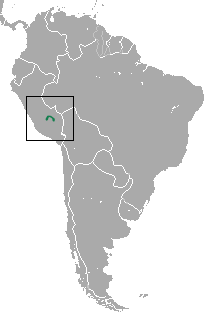Heavy-browed mouse opossum facts for kids
Quick facts for kids Heavy-browed mouse opossum |
|
|---|---|
| Conservation status | |
| Scientific classification | |
| Genus: |
Marmosa
|
| Species: |
andersoni
|
 |
|
| Heavy-browed mouse opossum range | |
The heavy-browed mouse opossum (also called Marmosa andersoni or Anderson's mouse opossum) is a small animal. It belongs to the opossum family, called Didelphidae. This special opossum only lives in a small area in southern Peru. It likes to live in forests. This opossum is active at night (which means it's nocturnal) and likely spends most of its time in trees (which means it's arboreal).
Contents
What Does It Look Like?
Scientists have only seen a few heavy-browed mouse opossums. This means we do not know a lot about them yet. Their fur is dark grey on top. It has reddish-brown tips. Their belly fur is lighter in color.
The fur on their cheeks and chin is a creamy color. They have clear black rings around their eyes. These opossums have big, thin ears. This helps them hear very well.
Their tail is longer than their head and body. The tail is furry near the body. It has bristles that get longer and thinner towards the end. Each foot has five toes. Their big toe on the back foot can grab things. This, along with their tail, helps them live in trees.
Where Does It Live?
We do not know much about how this opossum lives. It is active at night. It probably spends most of its time in trees. These opossums eat mostly insects and fruits. They might also eat small lizards, bird eggs, and tiny rodents.
One place where this opossum was found had a mix of forest and bamboo plants.
Where Can You Find It?
The Anderson's mouse opossum has only been found in three places. These spots are in a narrow strip of land. This strip is along the base of the Andes mountains. It is in the Cusco region of southern Peru.
Life Cycle and Reproduction
Scientists have only found a few of these rare animals. One was found in 1954. A few more were found in the late 1990s. Because of this, we do not know much about their life cycle.
However, we can learn from other opossums that are similar. The heavy-browed mouse opossum likely spends most of its time in trees. It is also probably active at night.
Like all marsupials, their babies are born very tiny. They are not fully developed. Most of their growth happens while they drink milk from their mother. It is thought that they have a short pregnancy.
For example, a similar opossum, Marmosa robinsoni, has 6 to 14 babies. Their pregnancy lasts only about 14 days. The tiny babies are only about 12 millimeters long. They attach to their mother and stay there for about 30 days.
Unlike some marsupials, female mouse opossums do not have a pouch. They do not have a special pocket to carry their young. The babies' eyes do not open until they are about 39 to 40 days old. They are likely ready to live on their own after about 65 days. These opossums might only live for about one year.
Marmosa species build nests for shelter. They might also use old bird nests. Sometimes they use holes in trees or banana stalks. They probably do not stay in one nest for long. They use any safe spot they can find when the sun comes up.
Is It in Danger?
There are no big threats to this opossum right now. In one area, there are natural gas fields. Gas is being taken out of the ground there. But this only affects a small area.
In most of the places where this opossum lives, forests are not being cut down quickly. However, in some eastern areas, there are threats from growing coca crops.
See also
 In Spanish: Marmosa de Anderson para niños
In Spanish: Marmosa de Anderson para niños


